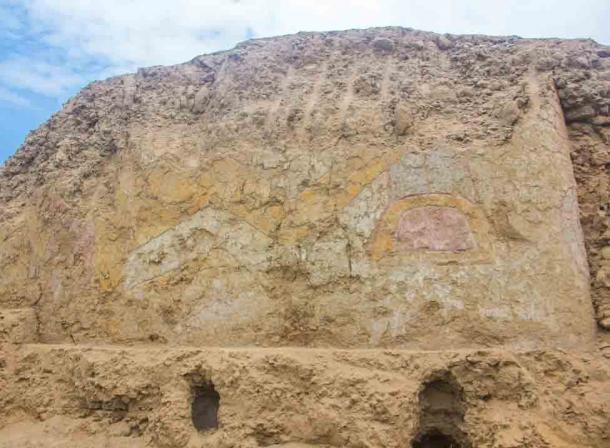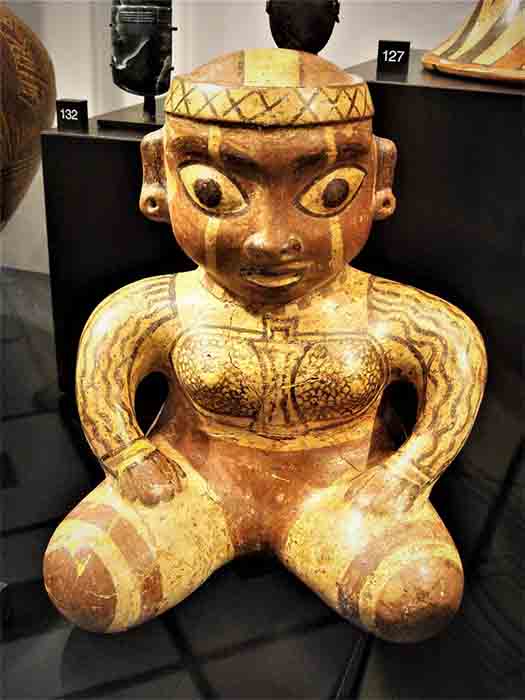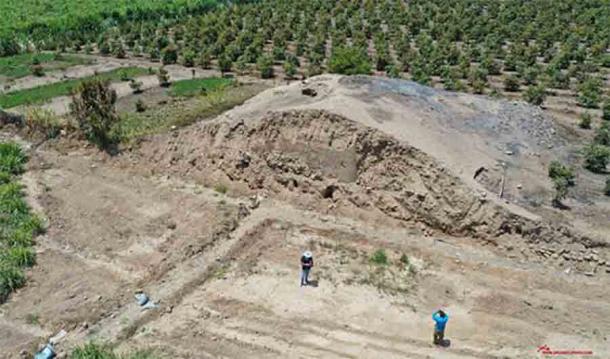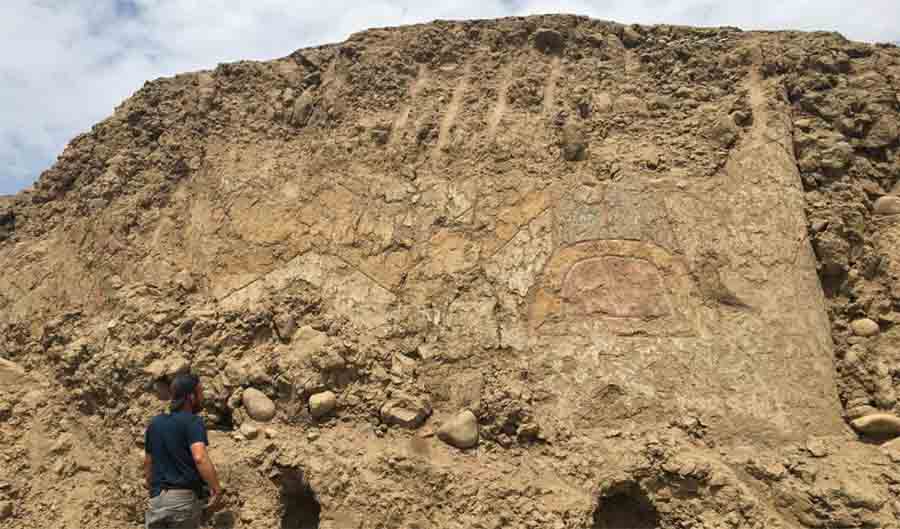Knife-Wielding Spider God Mural Found at Shrine in Peru
Archaeologists have identified a 3,200-year-old ceremonial center in Peru’s northern Virú province. The site has been partially destroyed and is still waiting full excavations, but they’ve already found a colorful mural of a knife-wielding spider god created by a pre-Columbian culture.
The spider god mural was created with shades of ocher, yellow, gray, and white. Experts believe it was made by Cupisnique artists at one of their ancient adobe temples to represent a water and fertility deity.

The colorful mural of a knife-wielding spider god. (ANDINA)
Who were the Mysterious Cupisnique People?
From roughly 1500 BC-200 BC, the pre-Columbian Cupisnique culture lived in the Jequetepeque Valley. Their influence has been found at sites such as Caballo Muerto, Cajamarca, Chavin, and in the northern highlands. The Cupisnique eventually merged with the Chavin culture, with which they have often been confused in the archaeological record.
- Water Cult’s Megalithic Temple in Peru was Re-Purposed for Death
- Exploring the Cupisnique Civilization: First Amongst the Supernatural Decapitators?
Cupisnique art and religion are believed to have influenced the Chavin culture (and possibly the later Moche too) and their most iconic art motifs are known collectively as the Supernatural Decapitators. Five distinct characters fall under this heading – the human, monster, bird, fish, and spider. Experts think that these figures are symbols of cyclical rebirth. Little else is known about the mysterious Cupisnique people.

Chavin-Cupisnique culture ceramic "Shaman" from about 1000 AD. (Public Domain)
The Accidental Discovery of an Ancient Shrine
Régulo Franco Jordán, the director of archaeology at the Fundación Augusto N. Wiese, told the Peruvian newspaper La República that the spider god mural was found in November 2020 when farmers accidentally happened upon it while using heavy machinery to extend their fields.
According to the archaeologist, the knife-wielding spider god is a sign that the site was a ceremonial center or a shrine dedicated to Pre-Columbian water gods. This idea is supported by the site’s location near a river. Régulo FrancoJordán explained the ancient association between the spider god mural and water:
“What we have here is a shrine that would have been a ceremonial centre thousands of years ago. The spider on the shrine is associated with water and was an incredibly important animal in pre-Hispanic cultures, which lived according to a ceremonial calendar. It’s likely that there was a special, sacred water ceremony held between January and March when the rains came down from the higher areas.”
Régulo Franco Jordán is best known for his role in the discovery of the Lady of Cao. His team unearthed the heavily tattooed body of the priestess or political leader in 2006. The Lady of Cao’s remains were found with a collection of artifacts and a possible human sacrifice and in 2017 her appearance was revealed to the world in a remarkable facial reconstruction.
- Hairless Dogs Hang Out at Peru’s Ancient Pyramids
- Recently Unearthed Head Collectors in Ancient Peru Might Not Be So Unique
Further Research will Have to Wait
Unfortunately, The Art Newspaper notes that the farmers “inadvertently destroyed” 60% of the ancient temple site before noticing the artwork and calling in the archaeological team. According to The Guardian, Régulo Franco Jordán has decided to call what’s left of the ancient temple “Tomabalito” because it’s near another archaeological site which is known as el Castillo de Tomabal.

Unfortunately, 60% of the Tomabalito site is believed to have been accidentally destroyed. (La República)
Now that the location has been registered with local authorities, Régulo Franco Jordán says that it’s been covered up for protection until researchers can return to work at the site and preserve the mural after the Covid-19 pandemic.
Top Image: The knife-wielding spider god mural was discovered at a 3,200-year-old ceremonial site in Peru. Source: Régulo Franco Jordán
By Alicia McDermott




















Comments
Hi All,
The only spider stories I can recall reading is the Anasazi Trickster Spider both covered in Africa an Mesoamerica apparently.
For me those were children's stories; however, I'm still in the midst of studying a rather fascinating Biblical Text an lectures online pertaining too Enoch. I've noted that each study each lecture agrees on this one topic...
Fallen Angel's known as The Watchers launched a number of experiments on the whole of Creation here on Earth many of those experiments were inflicted on all the Animal's, Bird's, Bugs and Insects, if that knife welding Spider deity is for Truth then evidence of what those Watcher Angel's did is proof.
Not everybody is going to agree with me on this and that's cool but, it's a possibility that being was real also not something I'd ever want to meet myself. I'll end this discussion here so until next time, Everyone, Goodbye!
It's always nice to read about new & develping ancient Native American cultures; bravo. But that ceramic statue accompaning the above article labled as a ‘Shaman’; shouldn't it be ‘Shawoman’? It's because of the apparent breast on the figure. And is this same statue an example of Decapitation Art of the Cupisnque/Chavin culture(s)? It appears to be kneeling but I see nothing of the lower leg.
Hi Alicia,
Do you have any info about those lines crossed horizontal and vertical above the spyder god mural ? It seems an ancient symbol. Thank you.
Daniela